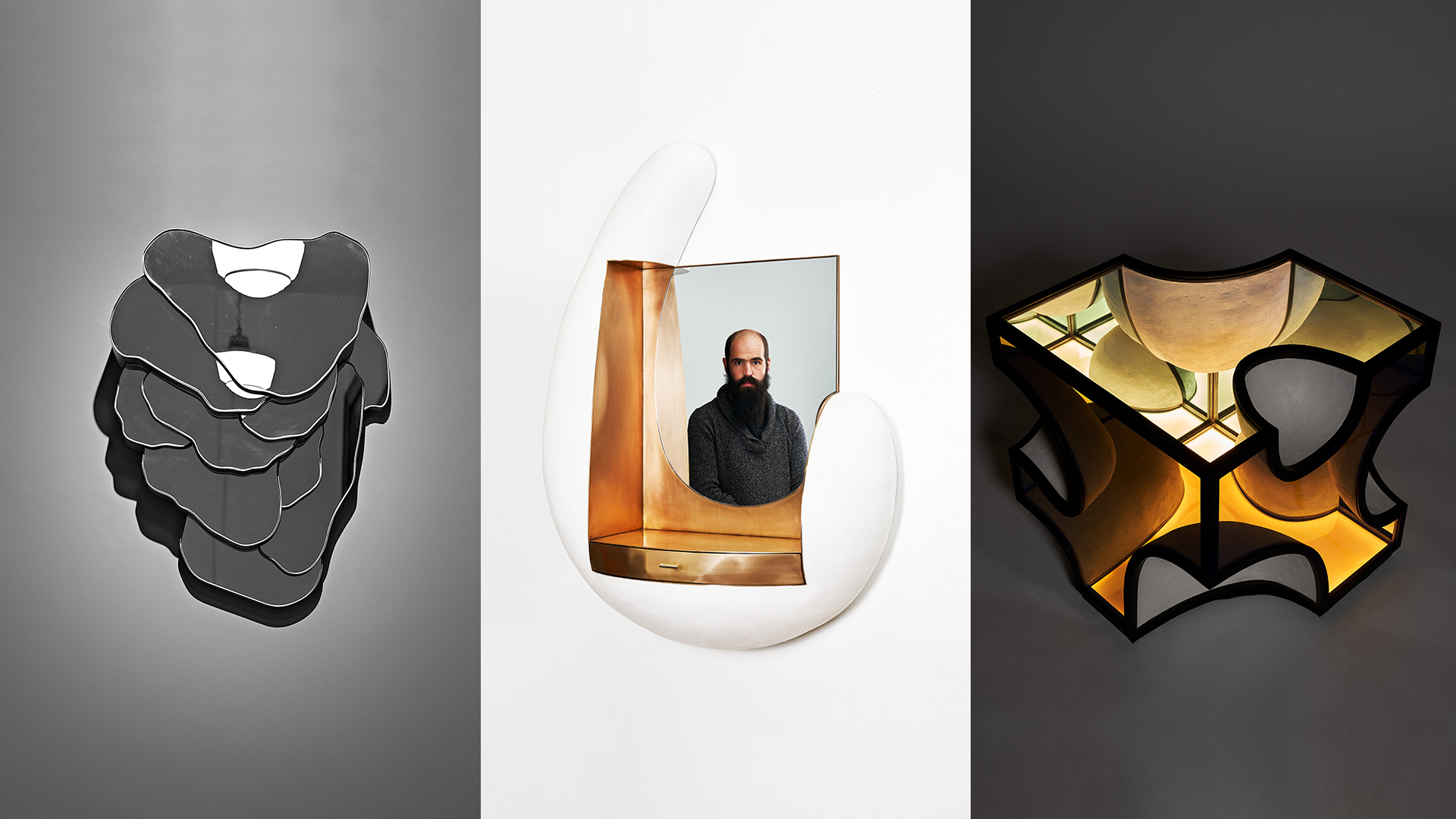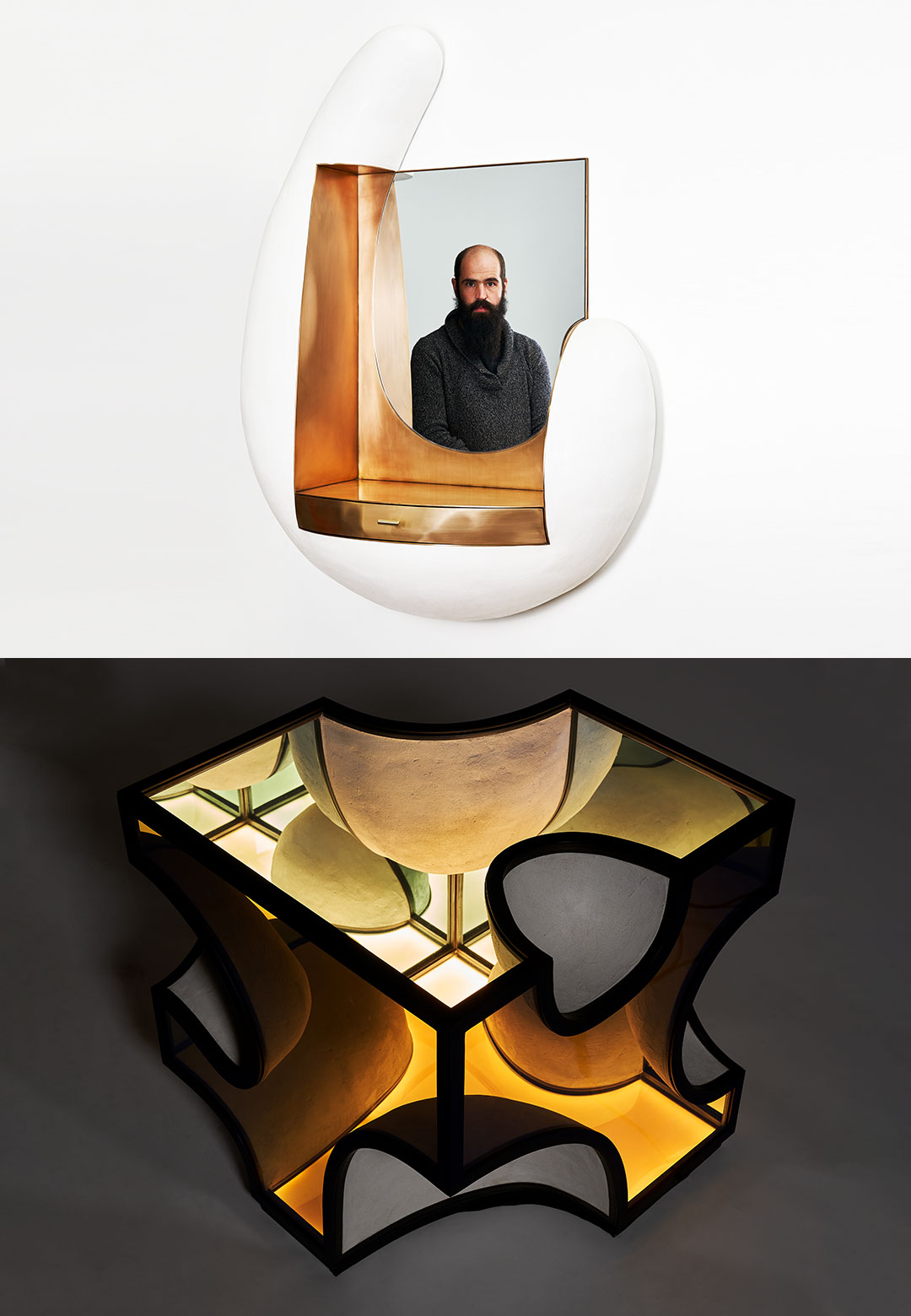Every so often comes along instances of product designs that are saturated with thought, transcending functionality—imaginary planes collide with unrestrained forms, or fresh textures bleed from surfaces to become objects illuminating purpose, beauty, and introspection. For Brooklyn-based creative J McDonald, conceiving sculptural objects is a means to explore the dissonances and dialogues between the human, non-human, and the natural world. Assaying into the complex relations between them, his creative practice vows to step beyond being ‘simply inspired by nature’—“It is an investigation of the contradictions inherent in being human—in existing simultaneously as a part of and apart from, the natural world,” he shares.
“From one perspective, we are—with all our self-awareness and complex thought, rationalism and whimsy, greed, and kindness—a natural and inevitable moment in the evolution of life on earth. We can see all our inequities, trash heaps, exhaust clouds, and wars, as an extension of nature, the predestined course of life on earth. Conversely, we can choose to believe that because we possess self-awareness and the ability to analyse, control and choose, evolution has bestowed upon us the responsibility to direct life toward a more harmonious existence. We are presented with a false choice between constraining our nature, or letting ourselves be wild, free, and devastatingly destructive,” he maintains.
From crafting mirrors that drip down walls to three-legged tables perched on arches, the American designer believes that the human psyche, much like the ecosystems we impact, is increasingly imbalanced. “We have overcome and eliminated many of the natural checks and controls, allowing our ingenuity to wreak havoc upon our world. We attempt to place our constraints on ourselves and others, but they are flawed or mistargeted and result mainly in literal and figurative prisons,” he asserts.
As a student of architecture, McDonald admits to possessing both, a rational, rectilinear creative side and an unrestrained, gestural, unconscious one, which together, feed into his eponymous practice, Studio J McDonald, operating out of New York, US. According to him, his years owning and operating a high-end metal fabrication studio are as relevant to his practice as his study of termite mounds while riding a bicycle across West Africa, and years living in NYC are as much an inspiration as solo backpacking trips to far-flung places.
His young practice, thus, is coloured with the complexities and contradictions posed in our environments, seeing the external world as an analogue of the human mind, wherein his works of art and design become an extension of understanding the contemporary relationships between the intuitive and rational, the natural and the built. Sculpture often spreads roots within furniture designs, as his ‘intuitive whimsy’ finds perimeters of geometry, and organic structures are sliced with imaginary planes.
Before setting up his practice, the product designer and artist was simultaneously operating his metal fabrication business and pursuing sculpture independently. “It was something of a split life, managing a business detailing and producing high-end works for other artists and designers, while also travelling to artist residencies around the country and showing sculpture, often immersive or monumental works relating to architecture and the environment,” he tells STIR. “Frustrated with the lack of creativity in my everyday fabrication business, I wanted to meld the things I liked best about both of these disparate paths into one, [and] this is how Studio J McDonald was born,” he conveys.
He created his first pieces of furniture back in 2018 all on his own, at Brooklyn Designs, but it was only the forced time granted during the COVID pandemic that led him to develop newer works to be showcased at the Objective Gallery in Shanghai, resulting in his designs collecting momentum. McDonald now proudly works on his art and furniture full-time and is represented on four continents, balancing the editioning of existing pieces with the realisation of newer ideas, while delving into the themes and materials that make his sculptural designs distinct.
Through his journeyings, McDonald has evolved in terms of his materials palettes and technical abilities to execute complex objects. Earlier, he tended to leap from one idea to another fairly quickly, satiating his hunger for trying different things and leaving them behind just as swiftly. Now, he has grown into a creator who finds value in delving deeper into ideas, in slower, more intentional ways. “I have learned to be more patient with the work,” he acknowledges. “I have embraced a creative process that prototypes, models, and samples more than before. In the same vein, I would characterise my aesthetic as ‘otherworldly chic,’ ‘eroded minimalism,’ or even ‘neo-rectilinear.’
For instance, his ‘Terrace Mirror,’ conveyed in brass, steel, and wood, cites inspiration from travertine terraced irrigation systems on hillsides and rice paddies—both being collaborative constructions between humans and nature. “To me, a mirror is a way of transporting oneself, of seeing oneself somewhere else. When we look into the glassy water of a still lake and see ourselves, surrounded by trees and mountains, transformed by the ripples in the water, we become part of the lake. When you look into the ‘Terrace Mirror,’ you see a version of yourself fragmented by its cascading curvatures, and for that moment, you become a part of it,” he explains.
Pronounced with steel, foam, bronze, and gypsum cement, the ‘Innersection Vanity’ also features a reflective mirror surface that intends to place the viewer inside the piece, but to the American artist, it carries more conflict. “Where the ‘Terrace Mirror’ represents harmonious unity, a collaboration between nature and human, the curve and the plane, the intuitive and the controlled, the ‘Innersection Vanity’ represents a clash between those forces,” he shares. “The sculptural form is sliced by a rectangle, they both impact each other, and something new is created. Only with this slice, this entanglement between the human and nature, does the mirror come into being,” he continues.
Reflecting on the way we tend to perceive architecture and geometry as elements stable, unmoving, and inanimate, McDonald’s ‘Creature Table’ in patinated steel takes traditional forms and geometries of quintessential stability and tradition—the Roman arch and the rectangle—and challenges this perception. “With four corners and only three legs, the geometric principles of the design force the form into motion, the stability into dynamism. Through a simple gesture, it is given life. What if we imbued things we traditionally think of as inanimate with life? What if they really have a life?” he questions, with this emotive table design.
Hewed from blackened steel, gypsum cement, one-way mirror, glass, acrylic, and light, ‘Cube Variations 1’ goes a step further in his exploration, manifesting as something of a ‘perceptual puzzle.’ According to him, this contemporary design starts with a geometric ideal and never ends. “The rational cube is eroded by organic concavities, the logical eaten away at by timeless intuition. In one light, it is a solid object, in another, a glowing and infinite world. Again, the viewer can place oneself inside the object via reflection. It forces us to consider the interiority of an object, of the hidden worlds that each thing contains and asks us to consider the infinite interior worlds that we ourselves contain,” the furniture designer elaborates.
McDonald’s favourite material combination to work with is one of metals and plasters. He comprehends the former as a contemporary and industrial material—straight, flat, strong, and thin, while plasters are deemed earthy and ancient, lending themselves to complex curvatures which retain the marks of the maker. “The two materials work together from perspectives of functionality and aesthetics, but the pairing is also symbolic,” he shares.
“Though I do love a pop of colour as much as anyone else, my colour palette tends to be muted, as I prefer to allow the materials to speak for themselves,” he admits. Bronze and steel, particularly immersed with the use of chemical reactions and patinas, contain a world of colour within them, which he taps into, exploring its patinas extensively through his furniture. “I like to be honest with the piece, the process, and the material in my use of colour and application of finish,” he continues.
It is not hard to distinguish McDonald’s objects as amorphous, free-spirited, almost alive, which he reveals, is his intent. “I want them to feel alive!” he tells STIR. “A lot of design feels dead and stale to me. I think of our built spaces as environments, and I think it’s a lot more fun (and healthier) to live in an ecosystem full of living things than in a mausoleum,” he says. “That said, for the most part, there is an element of restraint in my work and forms too. There is a tension between that which is trying to live, trying to break free and that which is binding or constraining it. The ‘Creature Table’ is actually a very traditional form with traditional geometries. The Cube Variations series begins with a very minimal and rational form—but they reveal that within these timeless geometries, there exists a world of possibilities, of lives, of forms,” he explains.
McDonald does not shy away from revealing his many inspirations across the realms of art, design, and architecture: some figures in design whose works speak to him, in particular, include Neri Oxman, Isamu Noguchi, Nacho Carbonell, Zizipo Poswa, Ellissa Lacoste, and Mattia Bonetti. “But more than any one person, I am inspired by the world around me,” he clarifies. “Whether it is the subterranean and geological, the interstellar, the microcosmic, or the human, there is no shortage of inspiration in life,” he concludes, as he embarks on an exciting collaboration with the 21st Gallery in NYC this year, working towards a fresh design collection consisting largely of pieces in cast aluminium and cast bronze.






 Sign in with email
Sign in with email










What do you think?